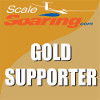Two of us in SoCal just received our LET 33% JS1 racers...I believe they are the first two in the US. The extremely thin wing section and high aspect ratio suggests these things should really move on the GPS Triangle course. 7 meter span, flap and aileron LDS linkages are all completely internal, and the wings carry two ballast tubes on each side. Very high level of completion - the model is delivered with all 10 wing servos installed, wing wiring and fuse side wing harnesses done, and the retract servo installed. Mounts are in place for the elevator, rudder and wheel brake servos.
This is my first LET model so I have no baseline to compare with, but Dennis Brandt had a close look today and he feels that LET has really upped their game on fit and finish.
Remaining build work should be fairly straightforward and I'm using PowerBox equipment for battery and servo management, dual redundant JR DMSS RXs, and a JR 28X radio sends the signals. Looking to debut at the Visalia Spring Aerotow this May.
This is my first LET model so I have no baseline to compare with, but Dennis Brandt had a close look today and he feels that LET has really upped their game on fit and finish.
Remaining build work should be fairly straightforward and I'm using PowerBox equipment for battery and servo management, dual redundant JR DMSS RXs, and a JR 28X radio sends the signals. Looking to debut at the Visalia Spring Aerotow this May.




Comment